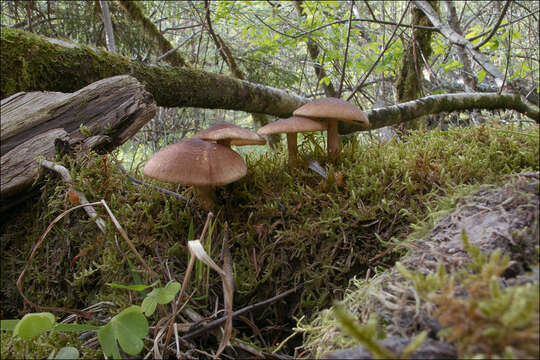Polyporus-ciliatus_21

Description:
Polyporus ciliatus Fr., syn.: Polyporus lepideus Fr.Fringed Polypore, DE: Maiporling, Bewinperter PorlingSlo.: etinasti luknjiarDat.: May 3. 2016Lat.: 46.35917 Long.: 13.70615Code: Bot_953/2016_IMG0124Habitat: Young riparian forest, Picea abies and Salix eleagnos dominant trees, next to a river; flat terrain occasionally flooded during high water levels of the river, calcareous, young alluvial ground; in shade, humid ground and air; partly protected from direct rain by tree canopies; average precipitations ~ 3.000 mm/year, average temperature 7-9 deg C, elevation 530 m (1.740 feet), alpine phytogeographical region.Substratum: fallen trunk of an old Salix eleagnos mostly not in direct contact with ground, still in bark, moss covered, in the late disintegration phase.Place: Lower Trenta valley, right bank of river Soa, between villages Soa and Trenta, next to the farm house Otokar, Trenta 4, East Julian Alps, Posoje, Slovenia EC Comments: According to its species name Polyporus ciliatus should have distinctly fringed edge of the pileus. However, this was barely so with this find. Apparently this trait is not very reliable. However, very small pores, barely seen by naked eye (6 pores/mm measured) and appearance in spring clearly distinct it from very similar Polyporus brumalis.About 50 pilei found on two places. Growing solitary and in groups, occasionally two fruitbodies confluent at the base of the stipe; pilei diameter from 35 to 70 mm, pore layer thin, up to 3 mm; stipe 3 - 5 cm long, 4 - 6 mm in diameter, equal and somewhat thicker at the base; pilei surprisingly sturdy, quite hard to cut and chew; smell mild, pleasant, mushroomy; taste distinct, mushroomy, somewhat unpleasant; SP abundant, whitish-light beige, oac851.Spores smooth. Dimensions: 5,4 [6 ; 6,2] 6,8 x 1,8 [2,1 ; 2,2] 2,5 microns; Q = 2,4 [2,8 ; 2,9] 3,3; N = 30; C = 95%; Me = 6,1 x 2,1 microns; Qe = 2,9. Olympus CH20, NEA 100x/1.25, magnification 1.000 x, oil, in water, fresh material. AmScope MA500 digital camera.Herbarium: Mycotheca and lichen herbarium (LJU-Li) of Slovenian Forestry Institute, Vena pot 2, Ljubljana, Index Herbariorum LJFRef.:(1) L. Ryvarden, I. Melo, Poroid fungi of Europe, Synopsis Fungorum 31., Fungiflora (2014), p 357. (2) J. Breitenbach, F. Kraenzlin, Eds., Fungi of Switzerland, Vol.2. Verlag Mykologia (1986), p 326. (3) A. Bernicchia, Polyporaceaes l., Fungi Europaei, Vol. 10., Edizioni Candusso (2005), p 460. (4) S. Buczacki, Collins Fungi Guide, Collins (2012), p 510. (5) G.J. Krieglsteiner (Hrsg.), Die Grosspilze Baden-Wrttembergs, Band 1, Ulmer (2000), p 609.
Included On The Following Pages:
- Life (creatures)
- Cellular (cellular organisms)
- Eukaryota (eukaryotes)
- Opisthokonta (opisthokonts)
- Nucletmycea
- Fungi (mushrooms, lichens, molds, yeasts and relatives)
- Dikarya
- Basidiomycota (basidiomycete fungi)
- Agaricomycetes (Mushroom-Forming Fungi)
- Polyporales
- Polyporaceae (bracket fungi)
- Lentinus
- Lentinus substrictus
This image is not featured in any collections.
Source Information
- license
- cc-by-nc-sa
- copyright
- Amadej Trnkoczy
- photographer
- Amadej Trnkoczy
- original
- original media file
- visit source
- partner site
- Flickr Group
- ID


